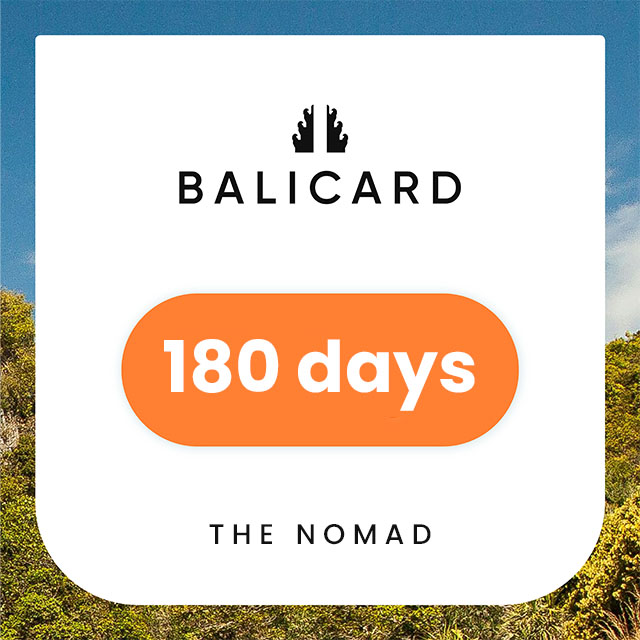développée par bali.com
BALICARD
Explorez Bali. Payez moins.
Obtenez votre carte de réduction GRATUITE et économisez 10 % ou plus chez 100 partenaires.
Carte SIM GRATUITE de 1 Go avec chaque BaliCard incluse
Villas, hôtels, location de voitures, rafting, canyoning, vélo électrique, trekking et visites touristiques, spa et remise en forme, restaurants, VTT, balançoires, plongée sous-marine, parc aquatique, spectacles de danse, cours de cuisine, transfert aéroport….
Choisissez votre carte de réduction
Une carte donne droit à des réductions pour jusqu'à 5 invités
Vous ne venez pas bientôt à Bali ?
Pas de problème, vous pouvez acheter dès maintenant votre carte de réduction Bali.com et choisir la date d'activation (date de votre arrivée). Ainsi, vous pouvez réserver à l'avance nos villas et hôtels partenaires. Vous pouvez choisir la date d'activation dans les 4 mois suivant votre achat.
Plus de 200 partenaires triés sur le volet
Parcs aquatiques et loisirs | Hébergement | Action - Aventure - Activités | Rafting | Cours (cuisine, fabrication de bijoux, cocktail, batik, poterie) | Plongée sous-marine | Trekking et randonnée | Location de voiture avec chauffeur | Prise en charge à l'aéroport | Restaurants et cafés | eSIM | Location de scooter | Clubs de plage et de jour | Coworking | Escape Rooms | Vélos électriques et cyclisme | Visites touristiques | Spectacles de danse | Spas et beauté | Canyoning | Cours de surf |
Comment ça marche
1. Achetez la carte de votre choix
Choisissez entre un forfait BaliCard sur 15, 30 ou 60 jours et achetez le ici, sur Bali.com
2. Recevez votre carte digitale par mail (pdf)
Vous recevrez un QR code (lien) qui vous permettra d’accéder à vos avantages chez nos partenaires
3. Présentez la BaliCard. Économisez.
Montrez vous carte digitale à nos partenaires qui en vérifieront la validité et vous accorderons votre réduction
Tout savoir sur la BaliCard - FAQ
- Un petit investissement, de grandes économies. Vous rembourserez votre carte après seulement une ou deux utilisations
- Gagnez l'accès à ce que Bali a de mieux à offrir, tous les partenaires sont choisis soigneusement et nous garantissons la qualité de leurs services et produits.
- Accédez à l'âme de Bali et bien plus. Bali.com est un membre affilié à l'Organisation Mondiale du Tourisme de l'UN, nous supportons et promouvons un développement durable et culturel pertinent. C'est pourquoi nous avons choisi des partenaires qui vous permettent de découvrir la beauté fondamentale de Bali et de ses habitants au-delà de ce qui est habituellement mis en avant sur internet.
- Engagez vous. Pour chaque achat d'une BaliCard, Bali.com donne 1USD à un programme de développement durable de Bali.
Non, le détenteur d'une BaliCard verra son nom associé à la carte digitale qu'il devra présenter lors de sa venue et d'une réseration.
Jusqu'à 5 personnes. Les bénéfices et réductions s'appliquent à l'acheteur de la carte et 4 autres personnes, à condition que le montant soit réglé en une fois. Up to 5 Guests. Certains de nos partenaires peuvent être enclins à ouvrir la réduction à plus de 5 personnes, mais il faudra vérifier directement avec leur organisation.
Pour chaque partenaire, cela peut être légèrement différent s'il s'agit d'un restaurant, d'un hôtel ou d'une activité. Les détails sur la façon de réserver ou de réclamer votre réduction sont toujours mentionnés sur la page du partenaire que vous pouvez trouver dans la liste des partenaires.
Certains partenaires fournissent un code promo pour leur système de réservation en ligne. Vous recevrez les codes dans votre mail de confirmation, après avoir acheté la BaliCard.
Certains partenaires exigent que vous les contactiez par mail ou WhatsApp pour effectuer une réservation.
Une fois que vous avez rendu visite au partenaire, veuillez informer le personnel que vous avez une BaliCard valide afin qu'il puisse en vérifier la validité et ainsi vous accorder la réduction ou les avantages.
Les employés de nos partenaires ont le droit de vérifier votre identité, ce qui n'est cependant généralement pas nécessaire
OUI! Vous pouvez acheter votre BaliCard en spécifiant la date de votre visite et d'activation de votre BaliCard
L'achat de cette carte n'est pas remboursable. Malgré tout, vous pouvez demander à en changer la date d'activation si vous rencontrez un imprévu, ou demander à transférer la carte à un autre nom.
Si vous avez besoin de quoi que ce soit, n'hésitez pas à contacter notre équipe (mail)
Nous nous efforçons de vous assurer une expérience fluide. Les problèmes de communication entre la direction du site partenaire et son personnel sont rares. Dans le cas où cela se produirait et qu'ils n'accepteraient pas votre BaliCard, vous pouvez d'abord leur demander de se référer à notre site web ici, où le nom du lieu et ses avantages associés sont affichés, et de contacter leur responsable pour obtenir de l'aide. S'ils ne sont pas en mesure de résoudre le problème, veuillez suivre cette procédure
- pas d'inquiétude, nous résoudrons ce problème pour vous
- prenez une photo de votre reçu( assurez vous que la date et l'heure soit visibles)
- demandez le nom de l'employé qui refuse de vous accorder la réduction (pour que nous ayons un point de référence)
- envoyez nous votre nom, le reçu et autres détails pour que nous puissions vous rembourser
- Whatsapp: +62 (0)813 5368 4470
- email: balicard@bali.com
Avec des années d'expérience et beaucoup de retours de nos précieux voyageurs, nous avons pu choisir les partenaires avec lesquels nous pouvons vous garantir la meilleure des expériences pour explorer les plus beaux aspects de Bali. Nous accordons une grande importance à la qualité pour assurer votre plaisir.
Termes et Conditions:
CHANGEMENT ET MODIFICATIONS
- Les partenaires de bali.com peuvent apporter des modifications à leurs bénéfices et réductions sans le notifier. Malgré tout, Bali.com fera de son possible pour que ces changements ne soient pas mis en place dans le mois suivant l'achat de la BaliCard, mais nous pouvons rien garantir
- Les bénéfices peuvent également cesser d'un jour à l'autre.
- Quand c'est possible, les clients doivent vérifier liste des partenaires ou les bénéfices qui sont mis a leur disposition sur Bali.com
- Les clients devront dégager Bali.com de toute responsabilité en cas de changement ou modification
RESPONSABILITÉ
En aucun cas, Bali.com ne pourra être tenu responsable des erreurs, omissions ou inexactitudes, ou des dommages ou pertes qui pourraient résulter de l'utilisation des informations ou des services fournis. En utilisant notre site Web ou nos services, les clients acceptent d'indemniser et de dégager de toute responsabilité Bali.com et ses sociétés affiliées, dirigeants, agents, partenaires et employés contre toute réclamation, dommage, perte, responsabilité, coût et dépense, y compris les honoraires d'avocat raisonnables, résultant de ou liés de quelque manière que ce soit à votre utilisation de notre site Web ou de nos services.
Les termes et contitions légaux peuvent être téléchargés ici

 English
English Indonesia
Indonesia Deutsch
Deutsch
















